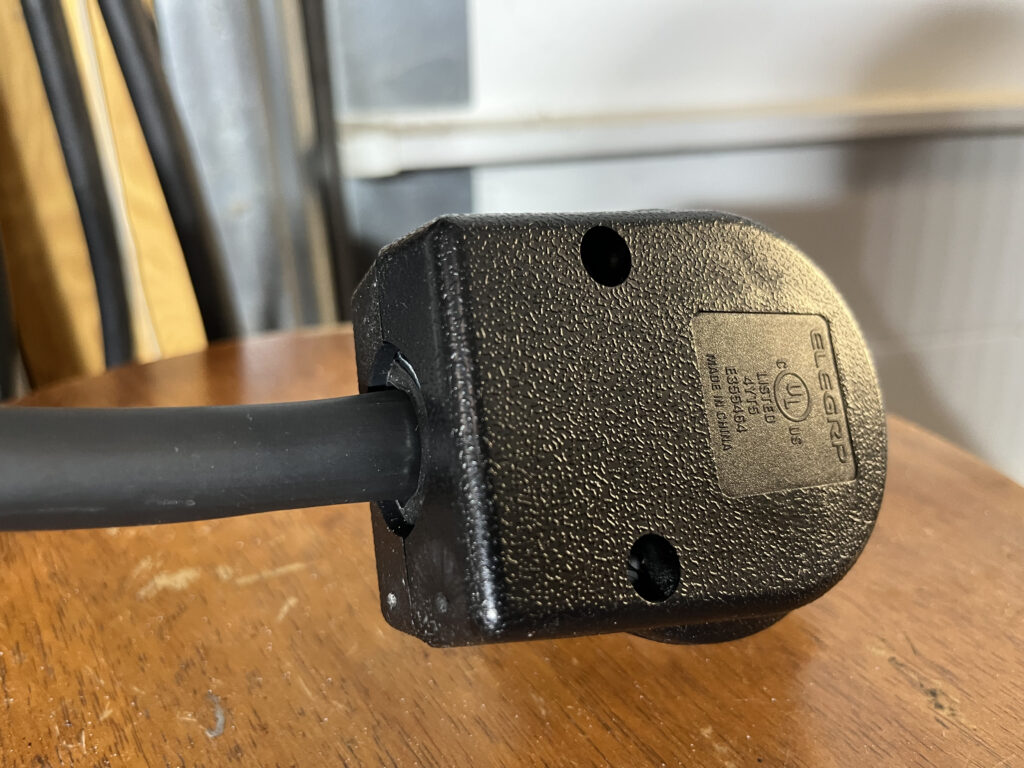Back in 2019 Tesla offered a 40 Amp High Power Wall Connector with a NEMA 14-50 plug. Unfortunately some of these had suboptimal welds from the cable to the terminals causing the plug to get warm. Fortunately Tesla has built in protection for hot plugs, which also can happen due to poor house wiring, and the unit elegantly cuts back the power output while flashing a yellow warning light.
The first time this happened to me, I swapped in an extra cable leftover from another unit that I hardwired and so it no longer needed its cable. They must have been from the same batch since a couple years later the new one also started to cut back current with a warm plug.

The simple solution of course is to cut the end off and replace the 14-50 plug. Easy enough. Except that the thermistor measuring plug temperature is now missing. The wall unit won’t charge without it. I could have bypassed the thermistor with a resistor, as I did on the hardwired unit, but in this case I appreciate the safety of the temperature sensor watching out for things getting warm.
The unit uses a 10K Ohm NTC thermistor to measure temperature. But what curve is it using? That I didn’t know. I had my suspicions that it might still be the same one they were using 20 years ago, the same curve that I’ve used for 30 years in the Zilla motor controllers. Since I have those lying around, and an oven handy, it was not too hard to compare the two.
It’s said that it’s better to lucky than smart, and it seems I’m lucky! The thermistor response matched perfectly with the one that I use for the Zillas. It’s a Vishay part number NTCLE100E3103JB0. If you need one send me a SASE and I’ll send you one. Or you can get them from Digikey here.





The above images show the resistance of the Tesla plug on the Yellow Fluke meter, my Zilla thermistor on the Radio Shack and the temperature is shown on the orange EXTECH with excellent match from 60 C to 100C.
Now it’s just a matter of replacing the plug and wiring in the thermistor as shown in the pictures below.
Which plug to buy is a challenge since many are cheaply made. I’m happy with this one I got for its thick brass terminals and secure wire clamps. The case plastic also seems quite tough. People have strong opinions about 14-50 plugs and sockets, feel free to research that rabbit hole if you like.
https://amzn.to/484A2lo -paid link

The important thing to know when wiring with this plug is that the rubber bushing sleeve for clamping goes on the cable before you start stripping it. Also, the thermistor is wired between the purple wire and the ground connection. The rest of the thin wires are not used. I used the orange scrap for the thermistor ground. The dual red and black wires are the hot leads, used in parallel for more power and flexibility.







Once it’s done, turn on the breaker and run it at full power for at least half an hour to check that the connector stays cool. The cord always gets a little warm at 40 Amps, but it should only get a little warmer near the ends.


Success! It’s all running well and cool again.
Paid links to supplies that I used:
https://amzn.to/3NiYBTw ELEGRP NEMA 14-30P & NEMA 14-50P Plug, 4 Prong Dryer/Range Oven Stove Angle Plug, Straight Blade Heavy Duty, 30 Amp 50 Amp 125/250V, Industrial Grade, Grounding, 3 Pole 4 Wire, UL Listed
https://amzn.to/3uQRtaV. Solder Seal Butt Terminal I would have used if I hadn’t misplaced it. So I soldered and used the green heat shrink instead.
https://amzn.to/3RbZUVI Dual Wall Adhesive Heat Shrink Tubing Kit I used for the outer layer on the thermistor
Feel free to ask questions or send feedback below.
This site contains paid links, by buying through these links I may receive a commission for the sale. This has no effect on the price for you.
